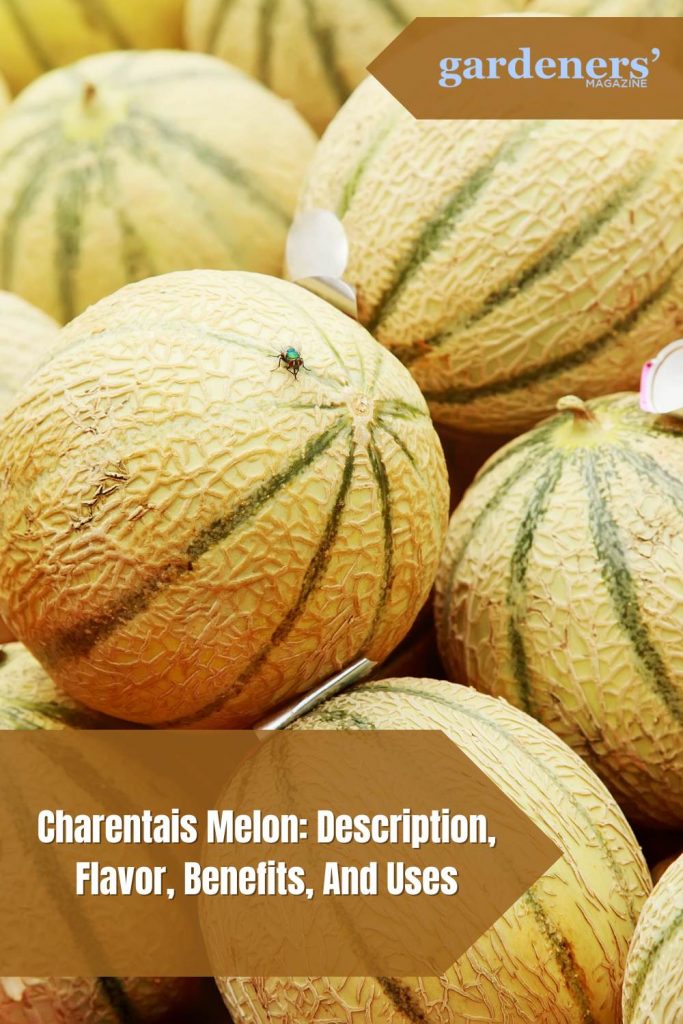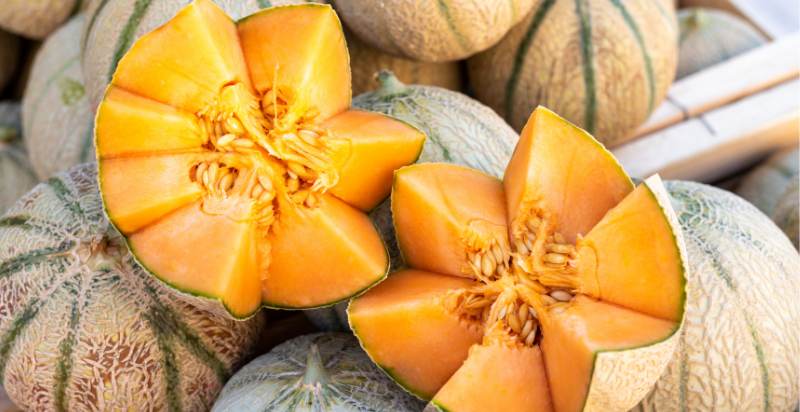Charentais melon is an old variety from the Charente region in southwestern France. The variety dates back to the 1500s, and its distinctive flavor has made it a popular choice among chefs and consumers worldwide. Charentais melons have a sweet, aromatic taste like a combination of honeydew and cantaloupe. They also have a distinctive orange-yellow color and soft, juicy flesh. Here is everything you need to know about Charentais melon, from its unique history and flavor profile to how best to use it in recipes.
What is Charentais Melon?
Charentais melon is a variety of French cantaloupe known for its sweet flavor and juicy texture. It is usually pale green, with deep grooves running along it. The flesh of the Charentais melon can range from light yellow to orange-yellow and has a distinctive scent. Because of its unique taste, Charentais melon is a popular choice for desserts and salads. It is often served as an accompaniment to other fruits such as strawberries, blueberries, raspberries, and blackberries. Additionally, it can be used in smoothies or juices for an extra refreshing boost.

History and Origin of Charentais Melon:
Charentais melon is a European muskmelon known and grown since the 16th century. It is believed to have originated in either Spain or France, with some historians claiming it was first developed in the Charente region of western France. The melon has pale green skin, white flesh, and an intensely sweet flavor.
In recent years, Charentais melons have regained popularity in France, where they are often used to make a classic French soup called ‘Potage aux Melons.’ The melon is also popular in other parts of Europe and North America, where it can be found in specialty and farmers’ markets. Despite its centuries-old history, Charentais melons remain as popular and flavorful as ever.
Description of the Charentais Melon:
The Charentais melon is a type of muskmelon, also known as a ‘True cantaloupe.’ It has a lightly ribbed light green to yellow-green skin and sweet, fragrant orange flesh. It can be round or oval and normally weighs around 0.5-1 kg (1 – 2 lbs). Its flavor is subtly perfumed and sweet without other melons’ musky or tart notes. Charentais melon can be enjoyed raw, in salads, in fruit bowls, or with savory accompaniments such as prosciutto and cheese. It can also be used for making preserves, jams, and sorbets.
Cultivation of the Charentais Melon:
Charentais melons are relatively easy to grow in most parts of the world with warm climates. They prefer full sun and well-draining soil with a pH of 6.5 or higher. To keep the fruits from rotting, they should be planted in mounded rows that provide good air circulation around the plants. Melons can also be grown in large containers if they are topped up with fresh soil and compost each season.
Charentais melon vines can produce fruits from late summer to early fall when grown outdoors. To maximize the yield and quality of the melons, it is important to provide ample water and fertilizer throughout the growing season. Care should also be taken to monitor for pests and diseases, as melons can be vulnerable to various problems.
Harvesting of the Charentais Melon:
The Charentais melon is a delicate fruit that needs to be harvested carefully not to damage its soft skin. The ideal time for harvesting the Charentais melon is when it reaches a yellowish-green color and feels slightly firm to the touch. It should also have an intensely sweet aroma when ripe and ready for harvest.
The traditional method of harvesting is to hand-pick the melon when it has reached its optimum ripeness. This requires that the fruit be handled gently and with care to avoid bruising or splitting of the skin. It is also important to pick all the fruits on a given plant simultaneously so they can mature evenly. Depending on the variety, some melons may require resting for a few days after harvesting to intensify their flavor and sweetness.
What are the Health Benefits of Charentais Melon:
Charentais melon is a great source of vitamins and minerals, making it an excellent choice for overall health and well-being. It contains high levels of vitamin A, which helps to keep the eyes healthy and supports immune system function. It is also rich in antioxidants such as beta-carotene, which help protect the body from damaging free radicals that can cause disease.
Charentais melon is also a good source of folate, which helps to prevent congenital disabilities and supports proper cognitive development. It is also packed with potassium, essential for controlling fluid balance and blood pressure. Additionally, it contains dietary fiber that helps promote regularity and may help reduce the risk of certain digestive diseases. Lastly, it is a great source of vitamin C, which can help boost the immune system and protect the body from infections. These nutrients make Charentais melon an excellent choice for overall health and well-being.
What does Charentais Melon Taste Like?
Charentais melon has a sweet, mild flavor often described as reminiscent of honeydew or cantaloupe with hints of vanilla. It is an incredibly juicy fruit with many natural sugars, giving it a unique sweetness. The texture of this melon is smooth and creamy, making it ideal for salads or eaten fresh as a snack. The aroma of the Charentais melon is sweet and fragrant, with undertones of fruit and citrus.
When ripe, it has a bright yellow-orange hue that is both vibrant and appealing. Overall, the Charentais melon offers an amazing combination of sweetness, fragrance, texture, and color, making it one of the most beloved melons ever.
Where Does Charentais Melon Grow?
The Charentais melon is native to the south of France, specifically in the region of Charente-Maritime. The mild climate and temperate waters provide ideal growing conditions for these sweet and fragrant melons. The terroir provides a unique balance of soil nutrients, air temperature, and humidity for successful cultivation.
In France, some of the best melons are grown in the Poitou-Charentes region, stretching from La Rochelle in the east to Angoulême in the west. This area is known for its rich soil and warm summer temperatures that allow Charentais melon farmers to produce top-quality fruits. The fragrant variety is also grown in many other parts of France, including the Rhône Valley and Provence.
The Charentais melon is also grown in many other parts of the world, including North America, South America, Africa, and Asia. In the United States, they are primarily grown in California and Arizona. In Canada, they can be found in British Columbia and Quebec. In South America, melons are grown in Brazil and Peru.
In Africa, they are cultivated in Kenya, Tanzania, and Ethiopia. The Charentais melon has even been successfully grown in parts of Asia, including Japan and China. With more than 20 countries growing the flavorful fruit, it is no surprise that these beloved melons have become a global favorite.

Where can the Best Charentais Melon be Found in the Market?
The best place to find Charentais Melon is in your local farmers market. This seasonal fruit is popularly grown in the French region of Charente-Maritime, and its sweet and juicy flavor has made it a favorite among many chefs. You can also find Charentais Melon at specialty grocery stores or online from farm-to-table suppliers.
Some stores may offer pre-sliced melons that are convenient and ready to eat. However, the freshest and most flavorful Charentais Melon is best enjoyed when purchased fresh from a farmer’s market. You can also grow your Charentais Melon with access to the right climate and soil conditions.
What are the Things you Need to Keep in Mind when Buying Charentais Melon?
- Choose ripe melons – ensuring your melon is ripe and ready to eat is key. Look for ones with a sweet, fragrant aroma, feel heavy in the hand, and have a slight give when pressed. Avoid any bruises or soft spots indicating it’s past its prime.
- Check for origin – Charentais Melon is specific to certain regions, most notably the Charente region of France. Check the label for the origin and ensure it has been grown in the right area for an authentic flavor.
- Research different types – Charentais Melons come in various shapes, sizes, and colors depending on the variety. Do some research into what kind best meets your needs and tastes.
- Look for disease-free melons – ensure the melon is free of any disease, such as fungal or bacterial spots. This will ensure you get the best quality that lasts longer and tastes better.
What is the best way to store Charentais Melon?
The best way to store Charentais Melon is to keep it in a cool and dry place. It should be put in a sealed container or plastic wrap and the refrigerator. The melon should be left at room temperature for up to two days as this will cause the fruit to spoil. If you plan to consume the melon within a few days, leaving it at room temperature is best. However, if you want to store the melon for an extended period, place it in the refrigerator.
To ensure that your Charentais Melon stays fresh and juicy for longer, keep it away from direct sunlight and heat sources. Additionally, it should be stored away from other fruits and vegetables, as it can absorb flavors or odors from them. Lastly, check the melon often for any signs of spoilage, such as mold or squishiness. If you notice any changes in the texture or smell of the melon, discard it immediately.
How to use Charentais Melon in recipes?
Charentais melon is a versatile fruit that can be used in various recipes. Here are some ideas for using Charentais melon in different dishes:
- Salads: Charentais melon makes a great addition to green salads or can be combined with other fruits and vegetables like apples, cucumbers, and tomatoes for a delicious twist on the traditional salad.
- Smoothies: Charentais melon is great for making delicious smoothies. Combine it with other fruits like mango, banana, or pineapplev for a flavor-packed drink you can enjoy anytime.
- Salsas: Charentais melon makes an excellent addition to any salsa recipe. Dice the melon and mix it with tomatoes, onions, peppers, garlic, and your favorite herbs to create a unique and flavorful salsa.
No matter how you choose this unique fruit, Charentais melon will surely make any dish a delicious success. Enjoy experimenting with this sweet and juicy ingredient.
Conclusion:
Charentais melon is a delicious and nutritious fruit that can be enjoyed in many different recipes. To ensure the best taste and texture, store the melon properly in a cool, dry place away from direct sunlight and heat sources. Additionally, check the melon often for signs of spoilage, such as mold or squishiness. When you’re ready to use the melon, there are plenty of ways to enjoy it, from salads and smoothies to salsas. Have fun experimenting with this sweet and juicy fruit!
- Everything You Wanted to Know About Red Tamarillos - June 2, 2025
- A Guide to Tulips: Everything You Need to Know & More… - June 2, 2025
- Guanabana: Description, Flavor, Benefits, And Uses - May 27, 2025

6 thoughts on “Charentais Melon: Description, Flavor, Benefits, And Uses”
Comments are closed.